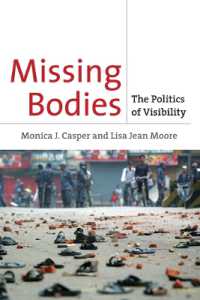- ホーム
- > 洋書
- > 英文書
- > History / World
Full Description
Buddhism, often described as an austere religion that condemns desire, promotes denial, and idealizes the contemplative life, actually has a thriving leisure culture in Asia. Creative religious improvisations designed by Buddhists have been produced both within and outside of monasteries across the region—in Nepal, Japan, Korea, Macau, Hong Kong, Singapore, Laos, Thailand, and Vietnam. Justin McDaniel looks at the growth of Asia's culture of Buddhist leisure—what he calls "socially disengaged Buddhism"—through a study of architects responsible for monuments, museums, amusement parks, and other sites. In conversation with noted theorists of material and visual culture and anthropologists of art, McDaniel argues that such sites highlight the importance of public, leisure, and spectacle culture from a Buddhist perspective and illustrate how "secular" and "religious," "public" and "private," are in many ways false binaries. Moreover, places like Lek Wiriyaphan's Sanctuary of Truth in Thailand, Su?i Tiên Amusement Park in Saigon, and Shi Fa Zhao's multilevel museum/ritual space/tea house in Singapore reflect a growing Buddhist ecumenism built through repetitive affective encounters instead of didactic sermons and sectarian developments. They present different Buddhist traditions, images,and aesthetic expressions as united but not uniform, collected but not concise: together they form a gathering, not a movement.
Despite the ingenuity of lay and ordained visionaries like Wiriyaphan and Zhao and their colleagues Kenzo Tange, Chan-soo Park, Tadao Ando, and others discussed in this book, creators of Buddhist leisure sites often face problems along the way. Parks and museums are complex adaptive systems that are changed and influenced by budgets, available materials, local and global economic conditions, and visitors. Architects must often compromise and settle at local optima, and no matter what they intend, their buildings will develop lives of their own. Provocative and theoretically innovative, Architects of Buddhist Leisure asks readers to question the very category of "religious" architecture. It challenges current methodological approaches in religious studies and speaks to a broad audience interested in modern art, architecture, religion, anthropology, and material culture.
-

- 電子書籍
- 担当させていただきます。【合冊版】 4…
-

- 電子書籍
- 願ったり 叶ったり【マイクロ】(4) …
-

- 電子書籍
- 重油汚染 - ナホトカ号事故から船首回…
-

- 電子書籍
- 調停少女サファイア2 富士見ファンタジ…




